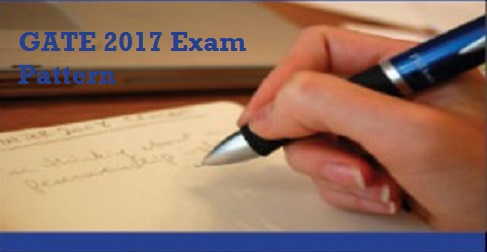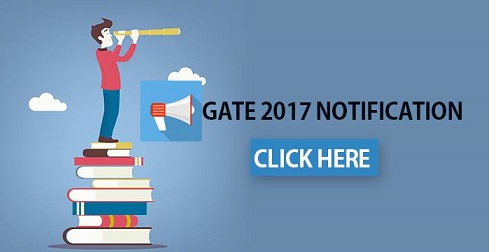GATE 2017 Syllabus: The official notification for the Graduate Aptitude Test in Engineering (GATE 2017) has been released and the registration has started. So, all the interested candidates fill your GATE 2017 Application forms before the last date and start your preparation now. GATE 2017 syllabus is different for all the branches. Candidates should check the exam pattern and the GATE 2017 Paper Syllabus before starting the preparation.
Here we are going to give you information about the GATE 2017 CSE Syllabus and exam pattern.
GATE 2017 Syllabus and Exam Pattern
Type of Questions: The GATE 2017 question paper will comprise of multiple-choice questions (MCQs) & numerical answer type questions (NATs). For MCQs, the candidates will be required to choose the right option from the available options. For NATs, the candidate will be required to enter the number value, the choice won’t be given.
- No. of Questions: The will be 65 questions of 100 maximum marks.
- Duration of the Exam: 3 hours
The GATE 2017 paper for CS branch will carry 15% marks of total marks for the Engineering Mathematics, General Aptitude section will contain another 15% marks & remaining 70% marks will be contained by the core subject of the paper.
The syllabus for General Aptitude Section will be defined separately. The GA section will contain 5 questions of 1 mark and 5 questions of 2 marks.
Also Check:
- GATE 2017 Exam Pattern (Branch Wise)
- GATE 2017 Application Form and Exam Details
- Tips for Cracking GATE Exam
- GATE 2017 Admit Card and Application Status
- GATE 2017 Cut Off Marks (Expected)
GATE 2017 Computer Science Syllabus
| COMPUTER SCIENCE AND INFORMATION TECHNOLOGY – CS & IT |
| Engineering Mathematics |
| Mathematical Logic: Propositional Logic; First Order Logic.Probability: Conditional Probability; Mean, Median, Mode and Standard Deviation; Random Variables; Distributions; uniform, normal, exponential, Poisson, Binomial.Set Theory & Algebra: Sets; Relations; Functions; Groups; Partial Orders; Lattice; Boolean Algebra.Combinatorics: Permutations; Combinations; Counting; Summation; generating functions; recurrence relations; asymptotics.Graph Theory: Connectivity; spanning trees; Cut vertices & edges; covering; matching; independent sets; Colouring; Planarity; Isomorphism.Linear Algebra: Algebra of matrices, determinants, systems of linear equations, Eigen values and Eigen vectors.Numerical Methods: LU decomposition for systems of linear equations; numerical solutions of non-linear algebraic equations by Secant, Bisection and Newton-Raphson Methods; Numerical integration by trapezoidal and Simpson’s rules.
Calculus: Limit, Continuity & differentiability, Mean value Theorems, Theorems of integral calculus, evaluation of definite & improper integrals, Partial derivatives, Total derivatives, maxima & minima. |
| GENERAL APTITUDE(GA): |
| Verbal Ability: English grammar, sentence completion, verbal analogies, word groups, instructions, critical reasoning and verbal deduction. |
| Computer Science and Information Technology |
| Digital Logic: Logic functions, Minimization, Design and synthesis of combinational and sequential circuits; Number representation and computer arithmetic (fixed and floating point).Computer Organization and Architecture: Machine instructions and addressing modes, ALU and data-path, CPU control design, Memory interface, I/O interface (Interrupt and DMA mode), Instruction pipelining, Cache and main memory, Secondary storage.Programming and Data Structures: Programming in C; Functions, Recursion, Parameter passing, Scope, Binding; Abstract data types, Arrays, Stacks, Queues, Linked Lists, Trees, Binary search trees, Binary heaps.Algorithms: Analysis, Asymptotic notation, Notions of space and time complexity, Worst and average case analysis; Design: Greedy approach, Dynamic programming, Divide-and-conquer; Tree and graph traversals, Connected components, Spanning trees, Shortest paths; Hashing, Sorting, Searching. Asymptotic analysis (best, worst, average cases) of time and space, upper and lower bounds, Basic concepts of complexity classes P, NP, NP-hard, NP-complete.Theory of Computation: Regular languages and finite automata, Context free languages and Push-down automata, Recursively enumerable sets and Turing machines, Undecidability.Compiler Design: Lexical analysis, Parsing, Syntax directed translation, Runtime environments, Intermediate and target code generation, Basics of code optimisation.Operating System: Processes, Threads, Inter-process communication, Concurrency, Synchronization, Deadlock, CPU scheduling, Memory management and virtual memory, File systems, I/O systems, Protection and security.
Databases: ER-model, Relational model (relational algebra, tuple calculus), Database design (integrity constraints, normal forms), Query languages (SQL), File structures (sequential files, indexing, B and B+ trees), Transactions and concurrency control. Computer Networks: ISO/OSI stack, LAN technologies (Ethernet, Token ring), Flow and error control techniques, Routing algorithms, Congestion control, TCP/UDP and sockets, IP(v4), Application layer protocols (icmp, dns, smtp, pop, ftp, http); Basic concepts of hubs, switches, gateways, and routers. Network security basic concepts of public key and private key cryptography, digital signature, firewalls. Web technologies: HTML, XML, basic concepts of client-server computing. |
So, all the candidates who are going to appear for the GATE 2017, should start their preparation after checking the GATE 2017 syllabus from here.












































![GATE 2017 Cut Off Marks- All Branches [Expected] GATE 2017 Cut off Marks](https://blog.meetuni.com/wp-content/uploads/2016/09/GATE-2017-Cut-off-Marks.jpg)









